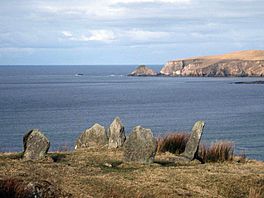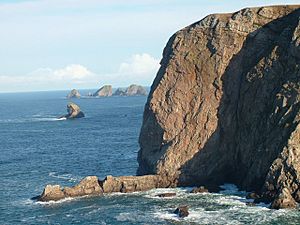Broadhaven Bay facts for kids
Quick facts for kids Broadhaven Bay |
|
|---|---|

Stone circle at Glengad overlooking bay
|
|
| Location | County Mayo, Ireland |
| Coordinates | 54°18′N 9°53′W / 54.30°N 9.89°W |
| Native name | Cuan an Inbhir Error {{native name checker}}: parameter value is malformed (help) |
| Ocean/sea sources | Atlantic Ocean |
| Max. width | 8.6 km (5.3 mi) |
| Official name: Blacksod Bay and Broadhaven | |
| Designated: | 7 June 1996 |
| Reference #: | 844 |
Broadhaven Bay (which is Cuan an Inbhir in Irish) is a natural bay on the northwest coast of County Mayo, Ireland. It is part of the Atlantic Ocean. The bay opens towards the north and stretches for about 8.6 kilometers (5.3 miles). It lies between Erris Head in the west and Kid Island in the east.
The bay is surrounded by the areas of Kilcommon, Kiltane, and Kilmore Erris. The land around it is mostly made of wet, spongy blanket bog. There are also some areas with machair (a special type of grassy plain) and lovely white sandy beaches. Not many people live here, but small groups of homes are found along the coastline.
Contents
A Special Place for Nature
Broadhaven Bay is very important for nature. In 2000, the National Parks and Wildlife Service (NPWS) named it a candidate Special Area of Conservation (SAC). This means it is a protected area because of its unique natural features.
This protection is for a few main reasons:
- The bay has four important types of habitats listed under special European Union rules (called the Habitats Directive). These include Atlantic salt marshes, tidal mudflats, reefs, and large shallow bays.
- It is home to some unusual groups of sea creatures and plants.
- Certain wild birds, like terns, come here to breed in the summer. Other wild birds spend their winter here.
Also, the inner part of Broadhaven Bay, known as Sruwaddacon Bay, is a Special Protection Area (SPA) for birds. This area, along with the nearby Glenamoy Bog complex, is very important for wintering wild birds, especially brent geese. These geese are protected under European bird laws.
A Look Back in Time
Broadhaven Bay has a rich history, especially linked to the sea.
Ships and Pirates
In the 1500s, during the time of the Spanish Armada, many Spanish ships were lost in the waters of North Mayo. One ship, the Santiago, sank right here in Broadhaven Bay. Over the years, many other ships have met their end in these waters. There are old tales of local pirates hiding away gold and treasures. They supposedly took these riches from unlucky ships that tried to find shelter from rough seas.
The Belmullet Canal
In 1715, an English landlord named Sir Arthur Shaen started building a small town. It was in a wet, marshy area near the Mullet peninsula. To make this area drier and create a shortcut for boats, Shaen had a canal dug. This canal would connect Blacksod Bay to Broadhaven Bay, allowing small boats to pass between them.
Building the town, which later became Belmullet, was slow. By the mid-1700s, the canal was blocked and could not be used. In 1845, the government gave money to help reopen the canal. Work started that year, but the terrible Irish Famine hit the area hard. Because of this, the canal was not finished until 1851. By 1851, reports showed that the canal was being used a lot. It even had a special bridge that could swing open to let boats through.
Broadhaven Lighthouse
At the northwestern entrance of Broadhaven Bay stands the Broadhaven Lighthouse. This lighthouse helps guide boats safely through the bay. The local lifeboat, which rescues people at sea, is based at Ballyglass pier nearby.
Around the bay, you can find many beautiful white sandy beaches. Some of the most popular ones are at Carrowteige/Rinroe, Glengad, and Inver.
Amazing Wildlife
Broadhaven Bay is a fantastic home for many sea animals, especially marine mammals like dolphins and seals. These animals are protected by Irish laws and European rules.
Five main marine mammal species that live in Irish waters are especially protected. All five of these can be found in Broadhaven Bay:
- Common bottlenose dolphin (Tursiops truncatus)
- Harbour porpoise (Phocoena phocoena)
- Gray seal (Halichoerus grypus)
- Harbour or common seal (Phoca vitulina vitulina)
- European otter (Lutra lutra)
The Stags of Broadhaven
The Stags of Broadhaven, known as Na Stácaí in Irish, are a group of five sharp, rocky islands. They are located off the tall cliffs of Benwee Head in the Kilcommon area. Even though they are just over a mile from the mainland, they are considered separate from County Mayo.
The islands include a central island called Teach Dónal Ó’Cléirigh, which is the tallest. To the south is An Teach Mór, and to the east is An Teach Beag. The other two islands are Carraig na Faola and An t-Oighean (78 meters high). These islands rise steeply out of the sea, reaching over 100 meters (328 feet) above sea level. They are home to birds like puffins and petrels. One of the rocks has a long, narrow cave that goes all the way through it. The Stags are a popular spot for divers, canoeists, and adventurers.
Why Broadhaven Bay is Important for Sea Life
Broadhaven Bay is a very important home for many sea mammals and other marine life. This is because it has many different types of coastal habitats. These range from rocky areas at the bottom of the Benwee Head cliffs (where waves crash constantly) to calm, muddy areas at the upper end of the Sruth Fada Conn estuary.
Broadhaven Bay and its inlet, Sruth Fada Conn Bay, are quite small. However, they are possibly the only known area in Ireland where all five of the specially protected marine mammal species (listed above in the Wildlife section) are found regularly. The bay is rich in different species, with 72 types of creatures counted.
In the parts of the bay that get a lot of waves, you can find the anemone Phellia gausapata in shallow water. A cave in deeper water is home to colonies of the rare anemone Parazoanthus anguicomus and a soft coral called Alcyonium glomeratum. In the outer bay, large beds of kelp (a type of seaweed) grow. Many different kinds of brown algae and sponges also live on the reefs.
The bay is also home to a rare crab called Pirimela denticulata and a hydroid (a small sea animal) called Tamarisca tamarisca. In the sandy areas under the water, you can find the burrowing urchin Echinocardium cordatum. Their hairy shells often wash up on the shores. Seagrass (Zostera marina) and oysters (Ostrea edulis) also live here.
Broadhaven Bay is very important for nature because it has several habitats listed under the EU Habitats Directive. These include large shallow bays, sandy areas exposed at low tide, reefs, sea caves, and salt marshes. These areas are also important for birds that breed here or spend the winter.
In the inner part of Sruth Fada Conn and other inlets of Broadhaven Bay, there are large mudflats that are uncovered at low tide. These mudflats are full of worms (polychaetes) and clams (bivalves). Atlantic salt marshes grow along the edge of the blanket bog here. You can find plants like turf fucoids, sea thrift, sea arrowgrass, Sea Plantain, and different types of salt marsh grasses and rushes.
Broadhaven Bay and its inlets support many breeding terns and black-headed gulls. It is also a key area for waterfowl that spend the winter here. Many species have important populations in this area, including the red-breasted merganser, ringed plover, grey plover, sanderling, dunlin, bar-tailed godwit, brent goose, oystercatcher, Eurasian golden plover, lapwing, knot, curlew, common redshank, and turnstone.
Overall, Broadhaven Bay and the waters of northwest Mayo are truly unique. Compared to other areas in Ireland, Broadhaven has a high number of different marine mammal species. In fact, 10 out of the 24 marine mammal species found in Irish waters have been seen here.
The Corrib Gas Project
In recent years, from about 2002 to 2014 and still ongoing, Broadhaven Bay has been part of the Corrib gas controversy. This was about a project to bring natural gas from the Corrib gas field, located offshore, to land.
The company involved, Royal Dutch Shell, planned to lay a pipeline through the bay. This pipeline would carry gas from the sea to a processing plant on land. There was a lot of disagreement about how this pipeline should be built and its possible effects on the environment and local community.
Local people and environmental groups raised concerns about the project. They worried about the impact of the pipeline on the bay's special protected habitats and wildlife. There were also concerns about the safety of the pipeline and how it would affect local fishing.
The company proposed to build a tunnel deep under the entire length of the bay to carry the pipeline. This was to address some of the concerns about laying the pipeline directly on the seabed in the protected bay. The project faced many challenges and reviews by Ireland's planning board, An Bord Pleanála, as people worked to find the safest and most environmentally friendly way to bring the gas ashore.





